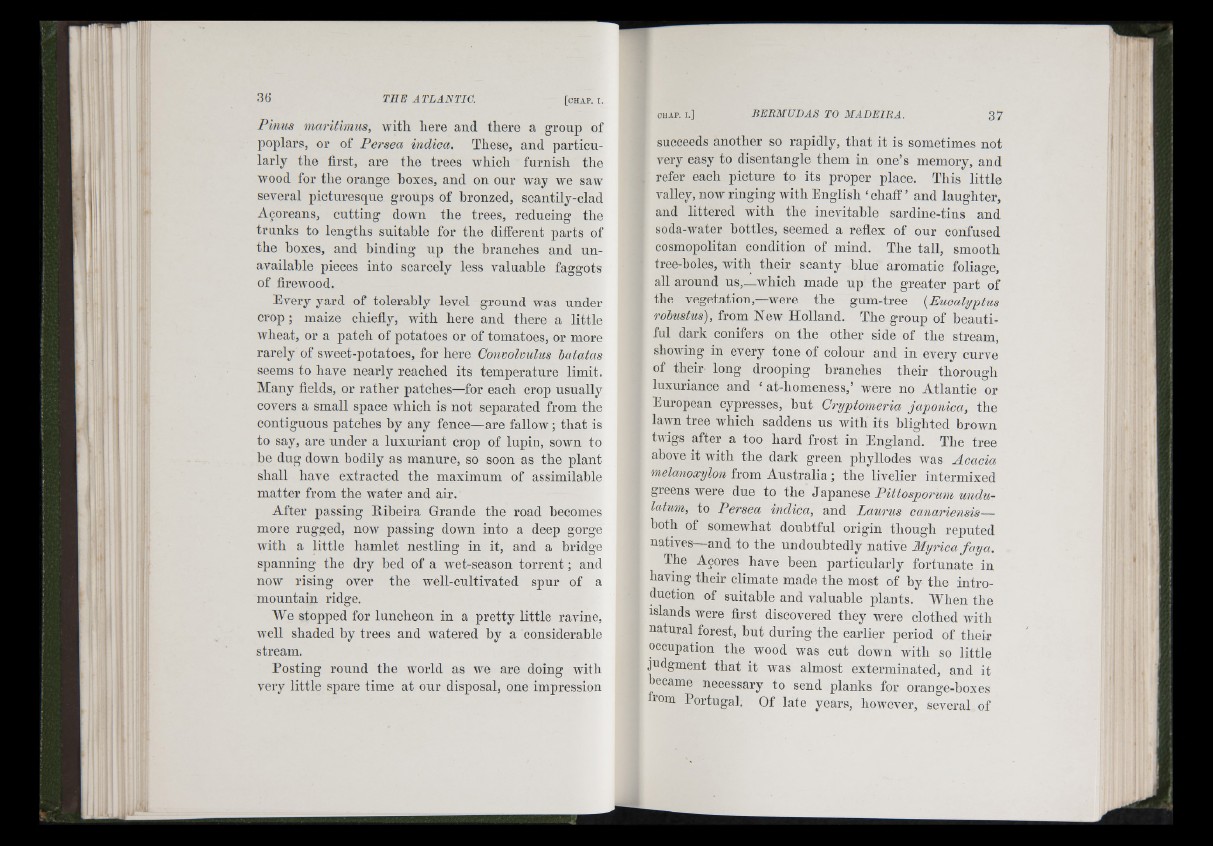
Pitms marUlmus, with here and there a group of
poj)lars, or of Persea indica. These, and p a rticu larly
the first, are the trees which furnish the
wood for the orange boxes, and on our way we saw
several picturesque groups of bronzed, scantily-clad
Acoreaus, cu ttin g down the trees, reducing the
tru n k s to lengths suitable for the different parts of
the boxes, and binding up) the branches and u n available
pieces into scarcely less valuable faggots
of firewood.
Every yard of tolerably level ground was under
crop ; maize chiefiy, with here and there a little
wheat, or a patch of potatoes or of tomatoes, or more
rarely of SAveet-potatoes, for here Convolvulus batatas
seems to have nearly reached its temperature limit.
Many fields, or rath e r patches—for each crop usually
covers a small space which is not sep)arated from the
contiguous patches hy any fence—are fallow ; th a t is
to say, are under a lu x u rian t crop of lupin, sown to
be dug down bodily as manure, so soon as the plant
shall have extracted the maximum of assimilable
matter from the water and air.
After passing Ribeira Grande the road becomes
more rugged, uoav paassing doAvn into a deep gorge
Avith a little hamlet nestling in it, and a bridge
spanning the dry bed of a Avet-season torrent ; and
noAV rising over the Avell-ciiltivated spur of a
mountain ridge.
AVe stopped for luncheon in a pretty little ravine,
Avell shaded hy trees and watered by a considerable
stream.
Posting round the Avorld as we are doing Avith
very little spare time at our disposal, one impression
succeeds another so rapidly, that it is sometimes not
very easy to disentangle them in one’s memory, and
refer each picture to its proper place. This little
valley, now ringing Avith English ‘chaff’ and laughter,
and littered with the inevitable sardine-tins and
soda-water bottles, seemed a reffex of our confused
cosmopolitan condition of mind. The tall, smooth
tree-boles, Avith their scanty blue aromatic foliage,
all around us,—Avhich made up the greater part of
the vegetation,—were the gum-tree {Eucalyptus
robustus), from New Holland. The group of beautiful
dark conifers on the other side of the stream,
shoAving in every tone of colour and in every curve
of their long drooping branches their thorough
luxuriance and ‘ at-homeness,’ were no Atlantic or
European cypresses, but Cryptomeria japonica, the
laAvn tree which saddens us with its blighted brown
tAvigs after a too bard frost in England. Tbe tree
above it with the dark green phyllodes Avas Acacia
melanoxylon from Australia ; the livelier intermixed
greens were due to the Japanese PUtosporum undu-
latum, to Persea indica, and Laurus canariensis—
both of somewhat doubtful origin though reputed
natives—and to the undoubtedly native Myrica fa y a.
The Açores have been particularly fortunate in
having their climate made the most of by the introduction
of suitable and valuable plants. When the
islands were ffrst discovered they were clothed with
natural forest, but during the earlier period of their
occupation the wood was cut down with so little
judgment that it was almost exterminated, and it
became necessary to send planks for orange-boxes
irom Portugal. Of late years, boAA’cver, several of